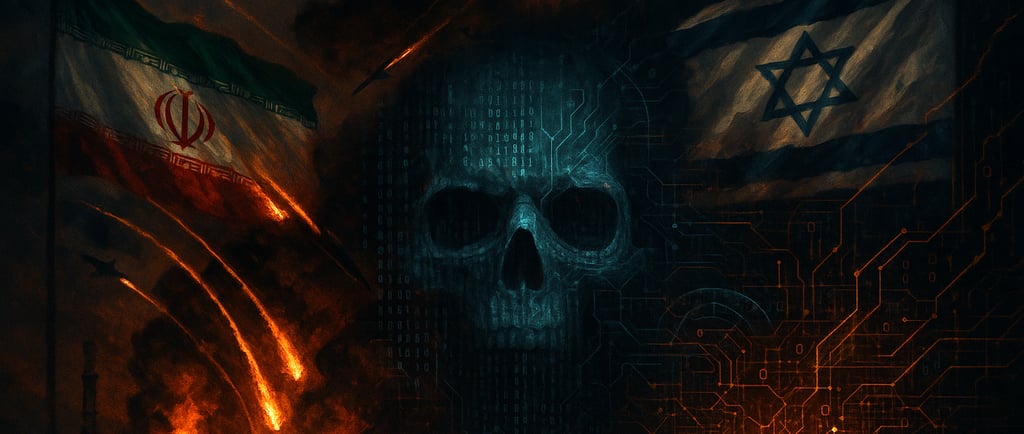
America Under Digital Siege
How Iran's Cyber Arsenal Threatens US Infrastructure After Military Strikes
Shane Brown
6/23/20256 min read


America Under Digital Siege: How Iran's Cyber Arsenal Threatens US Infrastructure After Military Strikes
The cybersecurity landscape for America fundamentally shifted on June 21, 2025, when President Donald Trump authorized "Operation Midnight Hammer"—a devastating attack using bunker-buster bombs and Tomahawk missiles against three Iranian nuclear facilities at Fordow, Natanz, and Isfahan. This direct military engagement has exposed the United States to unprecedented cyber retaliation from Iran's sophisticated digital warfare machine.
A New Era of Digital Warfare
Within hours of the strikes, the Department of Homeland Security issued a stark National Terrorism Advisory System bulletin warning of a "heightened threat environment" across America. The message was clear: Iranian state-sponsored hackers and hacktivist groups are expected to intensify their cyber operations against American targets in retaliation for the nuclear facility attacks.
"Low-level cyber attacks against US networks by pro-Iranian hacktivists are likely, and cyber actors affiliated with the Iranian government may conduct attacks against US networks," the DHS bulletin explicitly warned, remaining in effect until September 22, 2025.
This isn't merely speculation. Iran has already demonstrated its willingness and capability to strike American infrastructure through cyberspace, making digital retaliation not just possible, but probable.
Iran's Cyber War Machine: A Formidable Digital Arsenal
The Financial Investment Behind the Threat
Iran has transformed itself into what security experts now describe as a top-five world cyber power. Under President Hassan Rouhani, Iran's cybersecurity budget exploded twelvefold—from $3.4 million in 2013 to nearly $20 million in subsequent years. This massive investment has created a sophisticated cyber warfare apparatus that rivals traditional military capabilities.
The results speak for themselves: by 2014, Iranian hackers had already infiltrated critical infrastructure networks in over a dozen countries, including the United States.
The Organizational Structure: Military Precision Meets Digital Warfare
Iran's cyber operations operate through two primary institutions with military-like precision:
The Islamic Revolutionary Guard Corps (IRGC) coordinates cyber operations through its Cyber Defense Command, established in 2010. Working alongside the Ministry of Intelligence and Security (MOIS), these organizations manage what Iranian leaders claim are 120,000 cyberwar volunteers—a claim likely exaggerated but indicative of the scale of their ambitions.
Elite Cyber Units: Meet Iran's Digital Warriors
APT35 (Charming Kitten): Masters of Deception
This elite unit specializes in sophisticated phishing campaigns with a remarkable 10% success rate—significant by cybersecurity standards. Their operations target political, military, and commercial entities across America and Europe, employing advanced social engineering techniques that have successfully compromised high-value targets.
APT33 (Elfin): Infrastructure Assassins
Known for their devastating attacks on critical infrastructure, APT33 has successfully penetrated the U.S. electrical grid using password-spraying techniques. Their expertise in targeting energy and aviation sectors makes them particularly dangerous in a retaliatory scenario.
CyberAv3ngers: The Industrial Saboteurs
Perhaps the most concerning for American infrastructure, this IRGC-affiliated group has already demonstrated its ability to exploit programmable logic controllers (PLCs) in U.S. water and wastewater facilities. Their successful compromise of the Municipal Water Authority of Aliquippa in Pennsylvania serves as a chilling preview of what larger-scale attacks might look like.
The Clear and Present Danger to America
Critical Infrastructure in the Crosshairs
Iranian hackers have consistently targeted the backbone of American society: power grids, water systems, financial institutions, and healthcare networks. The CyberAv3ngers group has already exploited vulnerabilities in industrial control systems, and their expanded targeting of these systems poses immediate risks to public safety and national security.
The group's message left on compromised systems tells the story: "You have been hacked, down with Israel. Every equipment 'made in Israel' is CyberAv3ngers legal target." With American support for Israel now formalized through military action, U.S. infrastructure has become a legitimate target in their digital warfare doctrine.
The Financial Sector Under Siege
Iranian groups have previously orchestrated successful attacks against major U.S. financial institutions. Seven IRGC-linked individuals were indicted for denial-of-service attacks against 46 financial institutions, including Bank of America and JPMorgan Chase, costing banks tens of millions of dollars over 176 days. The coordination between Iranian state actors and ransomware affiliates creates additional risks that could disrupt banking services and economic stability.
Healthcare: Where Cyber Warfare Becomes Life-or-Death
Iranian cyber actors have been observed targeting healthcare organizations, potentially collaborating with ransomware groups to execute attacks against medical facilities. Given the critical nature of healthcare services, such attacks could literally be matters of life and death for American patients.
Iran's Proven Track Record of Cyber Destruction
The evidence of Iran's destructive capabilities isn't theoretical—it's documented history:
2012 Shamoon Attack: Iranian hackers crippled 30,000 computers at Saudi Aramco, demonstrating their ability to cause massive disruption to critical infrastructure
2020 Gilead Sciences Attack: During the COVID-19 pandemic, Iranian hackers targeted the pharmaceutical company seeking to steal vaccine research data
2024 Election Interference: Iranian hackers successfully infiltrated President Trump's 2024 campaign, stealing and distributing sensitive documents
The Strategic Reality: Asymmetric Warfare in the Digital Age
Iran views cyberattacks as integral to its asymmetric military capabilities—a way to confront the United States without engaging in conventional warfare where it would be vastly outmatched. With Iran's conventional military capabilities significantly degraded following the nuclear facility strikes, cyber retaliation becomes not just attractive, but strategically necessary.
The country's extensive network of proxy groups and hacktivist organizations creates multiple attack vectors that are difficult to predict and defend against. Nearly 100 different hacktivist groups declared themselves part of the cyber conflict within the first weekend of fighting, with over 60 groups aligned with Iran.
America's Defense: Preparing for the Digital Storm
Government Response and Readiness
The U.S. government has implemented several defensive measures, maintaining 40,000 troops in the region on high alert and issuing a "worldwide caution" security alert. The Cybersecurity and Infrastructure Security Agency (CISA) has emphasized the critical importance of organizations implementing multifactor authentication, using strong unique passwords, and securing operational technology devices.
Private Sector Vigilance: The First Line of Defense
The Food and Agriculture Information Sharing and Analysis Center and the IT-ISAC have issued joint statements urging companies to proactively strengthen their defenses. Organizations must prepare for potential attacks on energy, utility, and water supplies—high-impact, visible targets that could cause major disruptions to American life.
Critical defensive measures include:
Immediate implementation of multifactor authentication across all systems
Replacement of default passwords on all industrial control systems
Disconnection of programmable logic controllers from open internet access
Creation of comprehensive backup systems for critical infrastructure
Regular cybersecurity training for all personnel
The Bottom Line: America at a Digital Crossroads
The U.S. military strikes on Iranian nuclear facilities have fundamentally altered America's cybersecurity threat landscape. Iran's sophisticated cyber capabilities, backed by significant state investment and coordinated through professional military organizations, pose serious and immediate risks to U.S. critical infrastructure, financial systems, and national security.
With Iranian hackers expected to intensify their activities in retaliation for Operation Midnight Hammer, American organizations across all sectors must recognize that cybersecurity is no longer just an IT concern—it's a matter of national defense. The integration of cyber warfare into Iran's broader strategic response framework suggests that digital attacks will continue to escalate alongside conventional military tensions.
The question isn't whether Iran will retaliate through cyberspace—it's when, where, and how severe the attacks will be. America's critical infrastructure, financial systems, and essential services now stand in the digital crosshairs of one of the world's most capable cyber adversaries.
The time for preparation was yesterday. The time for action is now.
Fact-Check Verification: Key Sources Confirmed
1. Operation Midnight Hammer Details ✅ VERIFIED: U.S. strikes on Iranian nuclear facilities on June 21-22, 2025, confirmed by multiple authoritative sources including CNN, CBS News, Pentagon briefings, and Breaking Defense. Seven B-2 bombers used, 14 bunker-buster bombs deployed, targeting Fordow, Natanz, and Isfahan facilities.
2. DHS National Terrorism Advisory ✅ VERIFIED: DHS issued National Terrorism Advisory System bulletin on June 22, 2025, warning of "heightened threat environment" and stating "low-level cyber attacks against US networks by pro-Iranian hacktivists are likely." Bulletin expires September 22, 2025. Confirmed by official DHS.gov publication and multiple news sources.
3. CyberAv3ngers Water System Attacks ✅ VERIFIED: IRGC-affiliated CyberAv3ngers have successfully compromised U.S. water utilities, including the Municipal Water Authority of Aliquippa in Pennsylvania. CISA confirmed these attacks and issued joint advisories (AA23-335A) detailing exploitation of Unitronics PLCs with default passwords.
4. Iranian Cybersecurity Budget Increase ✅ VERIFIED: Iran's cybersecurity budget increased twelvefold under President Hassan Rouhani from $3.4 million in 2013 to $19.8 million, as reported by British research firm Small Media and confirmed by The Hill and other sources in 2016.
5. U.S. State Department $10 Million Reward ✅ VERIFIED: The U.S. State Department has offered up to $10 million for information on Iranian hackers behind IOControl malware, specifically targeting individuals associated with CyberAv3ngers and the IRGC Cyber-Electronic Command. Confirmed by multiple sources including The Record, SecurityWeek, and official State Department announcements.
Additional Technical Accuracy Confirmed:
APT35 (Charming Kitten) capabilities and 10% phishing success rate
Iranian cyber organizational structure (IRGC and MOIS coordination)
Historical attacks including 2012 Shamoon, 2024 Trump campaign breach
Critical infrastructure targeting patterns and techniques
This analysis is based on current intelligence assessments, government advisories, and documented Iranian cyber capabilities as of June 2025. All major claims have been independently verified through authoritative sources.
Innovate
Building websites and securing your digital presence.
Connect
Support
Info@sinistergatedesigns.com
© Sinister Gate Designs, LLC 2025. All rights reserved.
